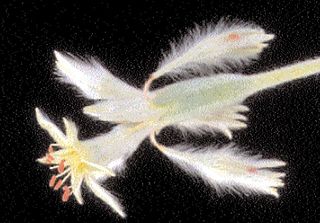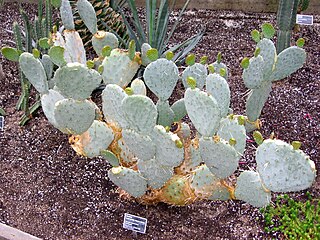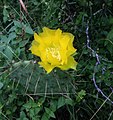
Cylindropuntia is a genus of cacti, containing species commonly known as chollas, native to northern Mexico and the Southwestern United States. They are known for their barbed spines that tenaciously attach to skin, fur, and clothing. Stands of cholla are called cholla gardens. Individuals within these colonies often exhibit the same DNA, as they were formerly tubercles of an original plant.

The strawberry hedgehog cactus or Engelmann's hedgehog cactus is commonly found in desert areas of the southwestern United States and the adjacent areas of Mexico, including the states of California, Nevada, Utah, Arizona, Baja California and Sonora.

Opuntia engelmannii is a prickly pear common across the south-central and Southwestern United States and northern Mexico. It goes by a variety of common names, including desert prickly pear, discus prickly pear, Engelmann's prickly pear in the US, and nopal, abrojo, joconostle, and vela de coyote in Mexico.

Opuntia gosseliniana, commonly known as the violet pricklypear, is a species of cactus that is native to Pima County, Arizona in the United States and Baja California, Chihuahua, and Sonora in Mexico.

Opuntia bentonii was proposed by some botanists to be a synonym of Opuntia stricta. However, O. bentonii, which grows in Texas, is separate and distinct from O. stricta.O. bentonii was clearly described by Griffiths in 1911. Along with O. stricta,O. bentonii was one of the pest pears of Australia in the early Twentieth Century.

The Tamaulipan matorral is an ecoregion in the deserts and xeric shrublands biome on the eastern slopes of the Sierra Madre Oriental range in northeastern Mexico. It is a transitional ecoregion between the Tamaulipan mezquital and the Sierra Madre Oriental pine-oak forests to the west and the Veracruz moist forests to the south. It is a desert shrubland where the flora mainly consists of woody shrubs, small trees, cacti, and succulents. Piedmont scrub occurs in shallow hollows and montane chaparral occurs above about 1,700 m (5,600 ft). There are a number of resident bird species and the mammals include Mexican prairie dog, Saussure's shrew, yellow-faced pocket gopher, Allen's squirrel, collared peccary and coyote.

Eriogonum longifolium, the longleaf eriogonum or long-leaf wild buckwheat, is a dicot of the family Polygonaceae. In addition to populations of E. longifolium var. longifolium found in Arkansas, Kansas, Louisiana, Missouri, New Mexico, Oklahoma, and Texas, there are varieties or subspecies that are geographically isolated and at various levels of endangerment. According to the University of Michigan Native American Ethnobotony database, Eriogonum longifolium has been used as a food by the Kiowa and as a medicinal by the Comanche.

Opuntia basilaris, the beavertail cactus or beavertail pricklypear, is a cactus species found in the southwest United States. It occurs mostly in the Mojave, Anza-Borrego, and Colorado Deserts, as well as in the Colorado Plateau and northwest Mexico. It is also found throughout the Grand Canyon and Colorado River region as well as into southern Utah and Nevada, and in the western Arizona regions along the Lower Colorado River Valley.

Opuntia, commonly called prickly pear, is a genus of flowering plants in the cactus family Cactaceae. Prickly pears are also known as tuna (fruit), sabra, nopal from the Nahuatl word nōpalli for the pads, or nostle, from the Nahuatl word nōchtli for the fruit; or paddle cactus. The genus is named for the Ancient Greek city of Opus, where, according to Theophrastus, an edible plant grew and could be propagated by rooting its leaves. The most common culinary species is the Indian fig opuntia.

Cylindropuntia californica is a species of cactus known by the common names California cholla, snake cholla, and cane cholla.

Opuntia aciculata, also called Chenille pricklypear, old man's whiskers, and cowboy's red whiskers, is a perennial dicot and an attractive ornamental cactus native to Texas. It belongs to the genus Opuntia prickly pear cacti. It is also widespread in Nuevo Leon, Tamaulipas.
Melitara texana is a species of snout moth in the genus Melitara. It was described by Herbert H. Neunzig in 1997 and is found in southern Texas and adjacent Mexico.
Melitara junctolineella is a species of snout moth in the genus Melitara. It was described by George Duryea Hulst in 1900. It is found in southern Texas and Mexico. The species has been introduced in Australia as a biological control agent of Opuntia stricta.

Opuntia macrorhiza is a common and widespread species of cactus with the common names plains prickly pear or twistspine pricklypear or Western pricklypear. It is found throughout the Great Plains of the United States, from Texas to Minnesota, as well as in the desert and Rocky Mountain states from Arizona to Idaho, with sporadic populations in the Mississippi and Ohio Valleys. It is also reported from northern Mexico, in the states of Chihuahua, Sonora, Coahuila, Nuevo León, Durango, Tamaulipas, and San Luís Potosí. The species is cultivated as an ornamental in other locations.

Opuntia pinkavae, common names Bulrush Canyon prickly-pear or Pinkava's pricklypear, is a species of cactus known only from northern Arizona and southern Utah. It grows in sunny locations in grasslands, on the edges of pinyon-juniper woodlands, on sandy or limestone soils.

Opuntia dulcis has been described as a variety of, and is confused with, O. phaeacantha. However, O. dulcis is a larger plant with ascending branches, to 2 ft. While it is a larger plant, immature specimens of O. dulcis may overlap in size with O. phaeacantha.

Opuntia anahuacensis is a cactus species in the genus Opuntia of the family Opuntioideae. It grows along the Gulf Coast of Texas, and perhaps northern Mexico. The plants are short, perhaps 1- or 2-ft tall, but they are wide. Some thickets may be 20- to 40-ft across and composed of multiple plants. The fruit is purplish. The cladodes are uniquely shaped, obovate with a neck. The original description claimed the plants were yellowish green, but they may be green or rarely blue-green.

Opuntia alta is a cactus species in the genus Opuntia. It is a large plant, with some older specimens forming trees to 4.6 metres (15 ft) tall.

Vernonia lindheimeri, commonly known as woolly ironweed, is a species of flowering plant in the aster family (Asteraceae). It is native North America, where it is native to the state of Coahuila in Mexico and to the state of Texas in the United States. Its natural habitat is in open, calcareous areas.

Perityle lindheimeri, commonly called Lindheimer's rock daisy, is a species of flowering plant in the aster family (Asteraceae). It is native to the United States, where it is endemic to the Edwards Plateau of Texas.



















